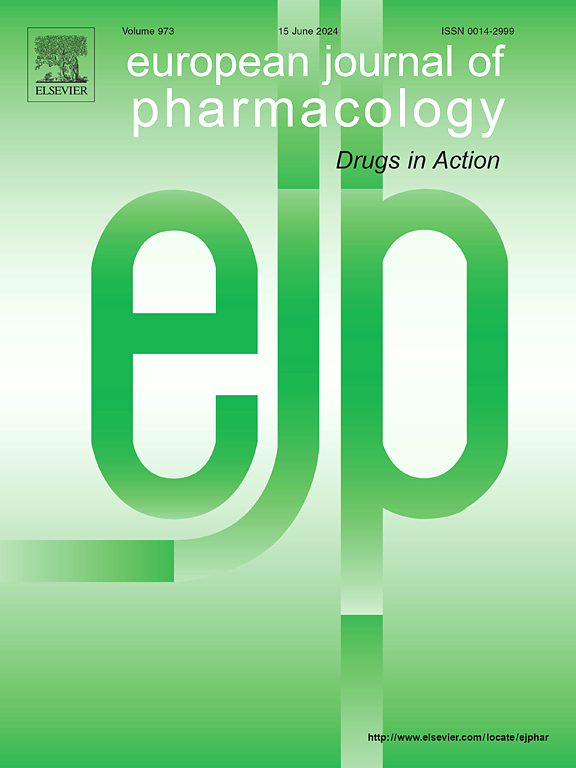Genkwanin blocks the interaction between phosphorylated JNK and NFATc1 to promote osteogenic differentiation and collagen Ⅰ α1 production
IF 4.2
3区 医学
Q1 PHARMACOLOGY & PHARMACY
引用次数: 0
Abstract
Genkwanin (GWA), a flavonoid compound found abundantly in various traditional Chinese medicines, has demonstrated pharmacological effectiveness against a range of diseases. However, its role in bone formation and the underlying mechanisms remain to be elucidated. The aim of this study is to investigate the effects of GWA on osteogenic differentiation and to uncover the possible mechanisms. Primary bone marrow-derived mesenchymal stem cells (BMSCs) and MC3T3-E1 cells induced for osteogenic differentiation were used as in vitro cell models. An ovariectomy (OVX) mouse model to induce secondary osteoporosis was used to evaluate the in vivo pharmacologic efficacy of GWA. Our studies revealed that GWA facilitated osteogenic differentiation and bio-mineralization of BMSCs and MC3T3-E1 cells in vitro, and could effectively prevent OVX-induced systematic bone loss and collagen Ⅰ α1 (COL1A1) reduction in vivo. Mechanism studies indicated that GWA could directly bind to phosphorylated c-Jun N-terminal kinase (pJNK) to prevent the phosphorylation of nuclear factor of activated T cells 1 (NFATc1) by JNK, thereby promote osteogenic differentiation and COL1A1 production via increasing the nuclear localization of NFATc1. This is distinct from the previously recognized function of the JNK/AP-1/NFATc1 signaling pathway in activating osteoclast differentiation. More importantly, GWA had no significant effects on estrogen-related signaling pathways, indicating a unique advantage in lowering the risk of gynecological cancer. In conclusion, our data suggest that GWA may be a promising candidate for the therapy of diseases associated with bone loss. Targeting pJNK-NFATc1 interaction may represent a new strategy to stimulate osteogenesis.

Genkwanin阻断磷酸化JNK与NFATc1的相互作用,促进成骨分化和胶原Ⅰα1的产生
根宽素(GWA)是一种富含各种中药的类黄酮化合物,已被证明对一系列疾病具有药理作用。然而,其在骨形成中的作用和潜在的机制仍有待阐明。本研究旨在探讨GWA对成骨分化的影响,并揭示其可能的机制。以原代骨髓间充质干细胞(BMSCs)和诱导成骨分化的MC3T3-E1细胞作为体外细胞模型。采用卵巢切除(OVX)小鼠继发性骨质疏松模型,评价GWA的体内药理作用。我们的研究发现,GWA在体外促进BMSCs和MC3T3-E1细胞的成骨分化和生物矿化,并能有效预防ovx诱导的体内系统性骨质流失和胶原Ⅰα1 (COL1A1)减少。机制研究表明,GWA可直接与磷酸化的c-Jun n -末端激酶(pJNK)结合,阻止JNK对活化T细胞核因子1 (NFATc1)的磷酸化,从而通过增加NFATc1的核定位,促进成骨分化和COL1A1的产生。这与先前认识到的JNK/AP-1/NFATc1信号通路在激活破骨细胞分化中的功能不同。更重要的是,GWA对雌激素相关信号通路无明显影响,在降低妇科癌症风险方面具有独特优势。总之,我们的数据表明,GWA可能是治疗骨质流失相关疾病的有希望的候选者。靶向pJNK-NFATc1相互作用可能是一种刺激成骨的新策略。
本文章由计算机程序翻译,如有差异,请以英文原文为准。
求助全文
约1分钟内获得全文
求助全文
来源期刊
CiteScore
9.00
自引率
0.00%
发文量
572
审稿时长
34 days
期刊介绍:
The European Journal of Pharmacology publishes research papers covering all aspects of experimental pharmacology with focus on the mechanism of action of structurally identified compounds affecting biological systems.
The scope includes:
Behavioural pharmacology
Neuropharmacology and analgesia
Cardiovascular pharmacology
Pulmonary, gastrointestinal and urogenital pharmacology
Endocrine pharmacology
Immunopharmacology and inflammation
Molecular and cellular pharmacology
Regenerative pharmacology
Biologicals and biotherapeutics
Translational pharmacology
Nutriceutical pharmacology.

 求助内容:
求助内容: 应助结果提醒方式:
应助结果提醒方式:


